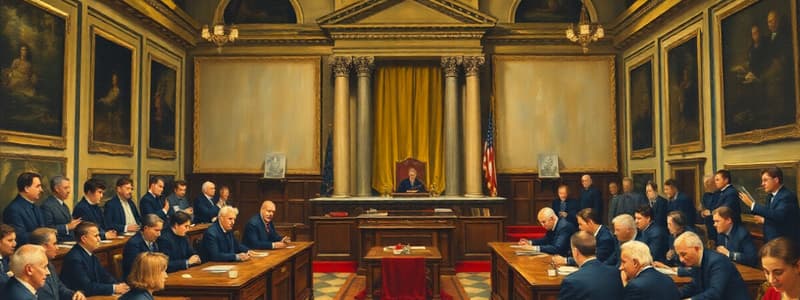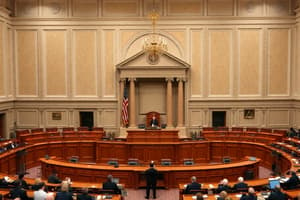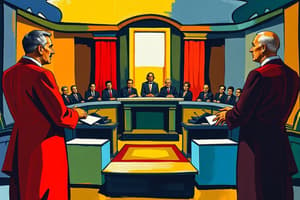Podcast
Questions and Answers
What type of legislature is Congress?
What type of legislature is Congress?
Bicameral (two chambers: House of Representatives & Senate)
How many members are in the House of Representatives?
How many members are in the House of Representatives?
435 members (based on population)
How many members are in the Senate?
How many members are in the Senate?
100 members (2 per state).
What are enumerated powers?
What are enumerated powers?
Name three enumerated powers of Congress.
Name three enumerated powers of Congress.
What is the Commerce Clause?
What is the Commerce Clause?
Congress can impeach the President?
Congress can impeach the President?
Who has the power to remove Congress members?
Who has the power to remove Congress members?
How often are House members elected?
How often are House members elected?
Who is the Speaker of the House?
Who is the Speaker of the House?
What can Congress investigate?
What can Congress investigate?
Why was the Parental Advisory label created?
Why was the Parental Advisory label created?
How is Congress viewed by the public?
How is Congress viewed by the public?
Why do incumbents get re-elected despite low approval?
Why do incumbents get re-elected despite low approval?
When was the last time Congress declared war?
When was the last time Congress declared war?
What power does Congress have over the military?
What power does Congress have over the military?
What is one of the oldest responsibilities of Congress?
What is one of the oldest responsibilities of Congress?
What does the Necessary and Proper Clause allow?
What does the Necessary and Proper Clause allow?
What is an incumbent?
What is an incumbent?
Why do incumbents usually win re-election?
Why do incumbents usually win re-election?
What is a marginal district?
What is a marginal district?
What is a safe district?
What is a safe district?
What is gerrymandering?
What is gerrymandering?
Why are House members more likely to be re-elected than Senators?
Why are House members more likely to be re-elected than Senators?
What is the representational view of voting?
What is the representational view of voting?
What is the organizational view of voting?
What is the organizational view of voting?
What is the attitudinal view of voting?
What is the attitudinal view of voting?
What is the role of the Majority Leader?
What is the role of the Majority Leader?
What is a Whip in Congress?
What is a Whip in Congress?
What is the line of succession for the presidency?
What is the line of succession for the presidency?
What are congressional caucuses?
What are congressional caucuses?
What is a standing committee?
What is a standing committee?
What are exclusive committees?
What are exclusive committees?
What are major committees?
What are major committees?
What is a select committee?
What is a select committee?
What is a conference committee?
What is a conference committee?
Who has the power to declare war?
Who has the power to declare war?
Who has the power to tax?
Who has the power to tax?
What is the Necessary and Proper Clause (Elastic Clause)?
What is the Necessary and Proper Clause (Elastic Clause)?
What is the Appropriations Committee responsible for?
What is the Appropriations Committee responsible for?
Why do incumbents usually win?
Why do incumbents usually win?
Flashcards
What is a bicameral legislature?
What is a bicameral legislature?
A legislature with two chambers: the House of Representatives and the Senate.
House of Representatives: Size?
House of Representatives: Size?
435 members, with representation based on each state's population.
Senate: Size?
Senate: Size?
100 members, with each state having two senators.
Enumerated Powers
Enumerated Powers
Signup and view all the flashcards
Enumerated Powers: Examples
Enumerated Powers: Examples
Signup and view all the flashcards
Commerce Clause
Commerce Clause
Signup and view all the flashcards
Can Congress impeach the President?
Can Congress impeach the President?
Signup and view all the flashcards
Who removes Congress members?
Who removes Congress members?
Signup and view all the flashcards
House Election Cycle
House Election Cycle
Signup and view all the flashcards
Senate Election Cycle
Senate Election Cycle
Signup and view all the flashcards
Speaker of the House
Speaker of the House
Signup and view all the flashcards
Congressional Investigations
Congressional Investigations
Signup and view all the flashcards
Public View of Congress
Public View of Congress
Signup and view all the flashcards
Incumbent Advantage
Incumbent Advantage
Signup and view all the flashcards
Last Congressional War Declaration
Last Congressional War Declaration
Signup and view all the flashcards
Congress & the Military
Congress & the Military
Signup and view all the flashcards
Oldest Congressional Responsibility
Oldest Congressional Responsibility
Signup and view all the flashcards
Necessary and Proper Clause
Necessary and Proper Clause
Signup and view all the flashcards
What is an incumbent?
What is an incumbent?
Signup and view all the flashcards
Marginal District
Marginal District
Signup and view all the flashcards
Safe District
Safe District
Signup and view all the flashcards
Gerrymandering
Gerrymandering
Signup and view all the flashcards
Representational View
Representational View
Signup and view all the flashcards
Organizational View
Organizational View
Signup and view all the flashcards
Majority Leader
Majority Leader
Signup and view all the flashcards
Congressional Whip
Congressional Whip
Signup and view all the flashcards
Presidential Succession
Presidential Succession
Signup and view all the flashcards
Congressional Caucuses
Congressional Caucuses
Signup and view all the flashcards
Standing Committee
Standing Committee
Signup and view all the flashcards
Conference Committee
Conference Committee
Signup and view all the flashcards
Study Notes
- Congress is a bicameral legislature, consisting of the House of Representatives and the Senate.
House of Representatives
- Has 435 members, with representation based on each state's population.
- Members are elected every 2 years.
- The Speaker of the House is the presiding officer, third in line for presidential succession.
Senate
- Has 100 members, with each state having 2 senators.
- Members are elected every 6 years, with one-third of the Senate up for election every two years.
- Senators are generally considered more powerful than representatives due to the smaller size of the chamber.
- It does not have a Speaker.
- Senators have unlimited debate time, which allows for filibusters.
Congressional Powers
- Congress possesses enumerated, implied, and inherent powers.
- Enumerated powers are explicitly listed in the Constitution, and include: the power to tax, regulate interstate commerce, coin money, declare war, levy taxes, approve treaties, and regulate commerce.
- Implied powers are derived from the Necessary and Proper Clause (also known as the Elastic Clause), allowing Congress to pass laws not explicitly listed in the Constitution.
- Inherent powers are those a government naturally has, such as buying land.
- Congress has the power to impeach and remove the President and can only be removed by itself.
- Congress funds the military, and can raise and support armies and create new military branches.
- Congress has the power to investigate the executive branch, judiciary, corporations, and social issues; for example, Congressional investigations into rock and roll lyrics in the 1980s led to the creation of the Parental Advisory label.
- It operates the U.S. Postal Service.
Legislative Process
- A bill becomes a law through a series of steps.
- The bill is introduced in either the House or Senate, followed by committee review in a standing committee.
- It proceeds to floor debate and a vote in the first chamber, then is sent to the other chamber for approval.
- If there are differences between the House and Senate versions, a conference committee is formed to reconcile them.
- Finally, it requires presidential approval to pass, whereafter the President may either approve it or veto it.
- Voting methods include voice votes (members shout "Aye" or "No") and roll-call votes (members electronically vote one by one).
Congressional Oversight and Support
- Congress can conduct oversight, including via congressional investigations.
- The Congressional Research Service (CRS) provides nonpartisan research.
- The Government Accountability Office (GAO) audits government agencies to ensure spending accountability.
- The Congressional Budget Office (CBO) estimates the financial impact of proposed legislation.
Congressional Membership and Elections
- Incumbents are current officeholders running for re-election, and usually win due to name recognition, fundraising networks, and media access.
- A marginal district is competitive, with closely contested elections, while a safe district is one where one party consistently wins by a large margin.
- Gerrymandering is the manipulation of district boundaries to favor one party.
- House members are more likely to be re-elected than Senators because House districts are smaller and often safe, while Senators must campaign statewide.
Influences on Congressional Voting
- The representational view involves representatives vote based on what their constituents want.
- Organizational view involves representatives voting based on party loyalty and leadership pressure
- The attitudinal view involves representatives vote based on their own beliefs and conscience.
Congressional Leadership and Structure
- The Speaker of the House is the presiding officer of the House and third in line for the presidency.
- The Majority Leader leads the majority party in the House or Senate and helps set the agenda.
- A Whip is a party official responsible for tracking votes and ensuring party discipline.
- The line of succession for the presidency is: President, Vice President, Speaker of the House, President Pro Tempore of the Senate, and Secretary of State.
- Congressional caucuses are unofficial groups in Congress that share political, ethnic, or economic interests.
Congressional Committees
- A standing committee is a permanent committee that handles specific policy areas
- Exclusive committees are those that members cannot serve on alongside others, like Appropriations, Rules, and Ways and Means.
- Major committees are high-priority committees like Armed Services, Foreign Affairs, and Judiciary.
- A select committee is a temporary committee created for a specific purpose, such as investigating an issue.
- A conference committee is a joint committee that reconciles differences between House and Senate versions of a bill.
- The Appropriations Committee decides how federal money is spent.
Key Congressional Concepts
- The Commerce Clause gives Congress the power to regulate interstate and international trade.
- A filibuster is a Senate tactic where a senator talks endlessly to block a bill from passing, and can be stopped with a cloture vote, requiring 60 votes to end debate.
- A Senate hold is a senator delaying a vote on a nomination or bill.
- Advice and consent refers to the Senate's power to approve or reject presidential nominations for Supreme Court Justices, Cabinet Secretaries and Ambassadors.
- The committee chair is the leader of a congressional committee, always from the majority party.
- The ranking member is the highest-ranking minority party member on a committee, who can become the new chair when Congress flips from one party to another.
- Logrolling is a deal where one legislator agrees to vote for another's bill in exchange for their support, and often involves funding for bridges, tunnels, stadiums, or district projects.
- The power of the purse is Congress's power to control federal spending by approving budgets.
- Pork-barrel legislation refers to laws that direct government funds to specific local projects to gain political support.
- The franking privilege allows members of Congress to send mail to constituents for free, but not for campaign materials.
Additional Information
- Congress has consistently low approval ratings.
- Congress last declared war in 1941 (World War II).
- Members of Congress can be re-elected indefinitely, as there are no term limits.
- The House Ways and Means Committee handles tax bills, and any new federal tax law must originate in the House.
Studying That Suits You
Use AI to generate personalized quizzes and flashcards to suit your learning preferences.



